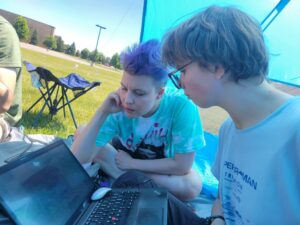Erin Coleman ‘25 (Physics and Mathematics) and Anne Monroe ‘25 (Physics and Mathematics) have been studying one of Jupiter’s storm activities using radio wave technology right here at Gustavus. This is their first research experience here on the Hill, and they have been busy collaborating all summer conducting astronomy research.

Coleman and Monroe knew they wanted to participate in research before attending Gustavus, and when the opportunity arose to conduct research, both students jumped at the opportunity. These Gusties are fueled by their curiosity and have always been on the search for ways to answer the why within our daily lives.
“I’ve always known I wanted to participate in science because I was the person in class who would ask ‘but why?’ when it came to understanding the world around us. To this day, I still hold onto the why instinct. I think that studying math and physics is the best way for me to get to the root of all why – something that will describe the fabric of the universe,” stated Monroe .
“I like solving problems and coming up with elegant solutions for its own sake. Solving problems doesn’t always need to be an urgent matter, it can simply be discovering what solutions can help our world in the future” added Coleman.
This summer, these first-year students have constructed their own radio telescope at Gustavus to track the storm activity on Jupiter by measuring the radio waves it produces. Coleman and Monroe are committed to their research, often trudging out to the field
by SouthWest Hall at 3am because “that’s when Jupiter’s awake”. Not only do they conduct fieldwork; they also spend their days interpreting the storm data they’ve collected with the telescope. 
Conducting research at Gustavus has provided Coleman and Monroe with many opportunities to make connections and present their work so far.
“Gustavus is a small school that allows you to make personal connections with your professors, especially in the department you are majoring in”, Coleman said.
“Presenting research at Gustavus pushed me to place a lot of thought into developing a cohesive presentation that espoused my values of making our research information accessible to everyone. It was an opportunity that allowed us to present the parts of the project that we were most excited about, and explain why the audience should be excited too”, stated Monroe.
Coleman’s research is funded by Gustavus’ FYRE program. FYRE stands for First-Year Research Experience. This program is dedicated to providing opportunities for students to engage in research experiences during the summer between their first and second years with a Gustavus faculty mentor in the Natural Sciences and Mathematics.
Monroe’s research is funded by the Harold Q. Fuller and Richard M. Fuller Physics scholarship, an award designated to encourage first-year physics students.
It’s with these opportunities that Gustavus provides that makes these experiences accessible for students who are interested in research regardless of year in school.
“Research experiences for undergraduates can be competitive, especially for first years. But knowing that Gustavus has research opportunities for their own students, gave me the confidence to apply to FYRE.” said Coleman
As summer comes to a close, Coleman and Monroe plan to continue developing their data collection techniques going forward with hopes to build a permanent site for their research collection in the future.